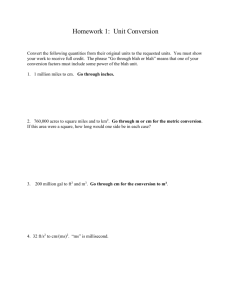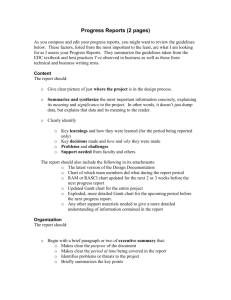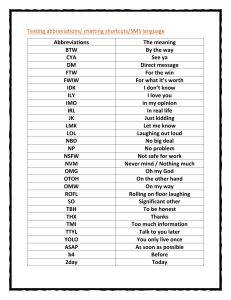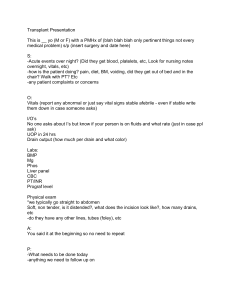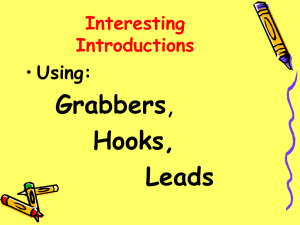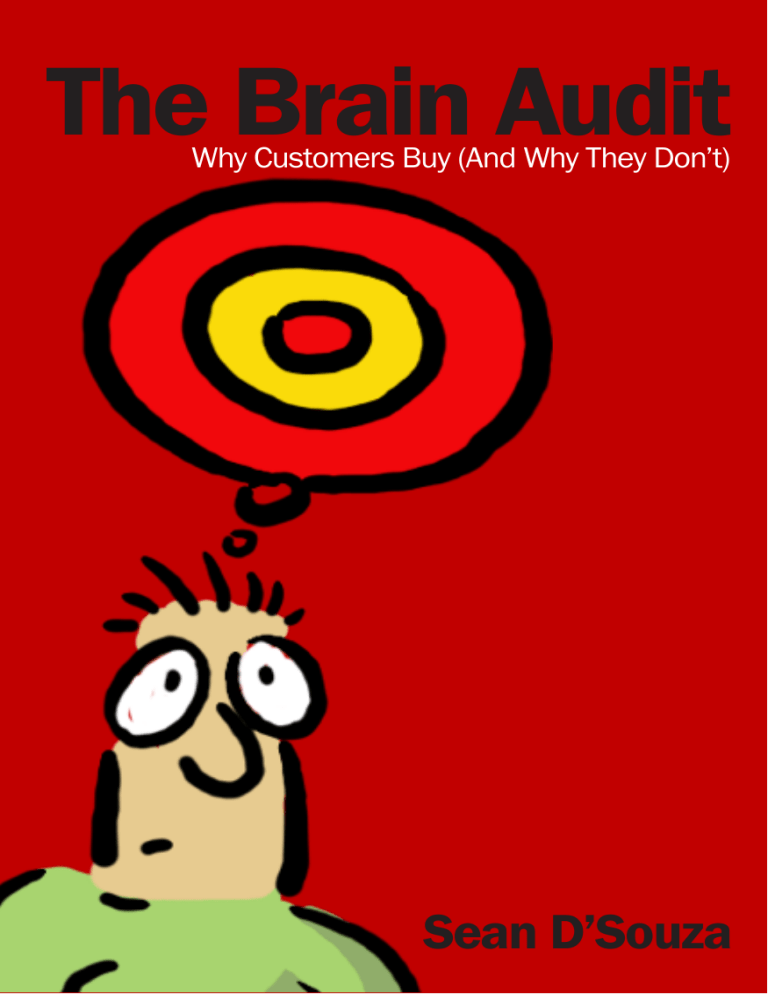
The Brain Audit Why Customers Buy (And Why They Don’t) Sean D’Souza The Brain Audit: Why Customers Buy (And Why They Don’t) Sean D’Souza Copyright ©2008 Sean D’Souza This book is published by Psychotactics Ltd. Notice of Rights: All rights reserved. No part of this book may be reproduced in any form, by photostat, microfilm, xerography, or any other means, or incorporated into any information retrieval system, either electronic or mechanical, without the written permission of the copyright owner. For information on getting permission for reprints and excerpts, contact sean@psychotactics.com or go online to www.psychotactics.com to send a message via the website. Notice of Liability: The information contained in this book and on the accompanying website is distributed on an “As Is” basis, without warranty. While every precaution has been taken in the preparation of the book, neither the author nor Psychotactics Ltd. shall have any liability to any person or entity with respect to any loss or damage caused or alleged to be caused directly or indirectly by the instructions contained in this book or by the computer software and hardware products described in it. Training Programs: Training. Yes, we do train staff. And we have trained staff. And we do have workshops and we do have online as well as live, in-person workshops. If you’re reading this, and are interested, there’s an address below. And a phone number. If you email us, expect to get a response in less than 24 hours. If you don’t get a response, it’s because your email has been lost somewhere in the great email graveyard. If so, pick up the phone and call. With today’s telephone costs, you’d be paying very little for a phone call, even if it were a long-distance call. For information on Psychotactics and Brain Audit Training Programs, contact: Online: www.psychotactics.com Snail Mail: PO Box 36461, Northcote, Auckland 0748, New Zealand. +64 9 449 0009 +64 21 2361415 Email: sean@psychotactics.com Secondary: sean@5000bc.com ISBN: 978-0-473-11738-2 Published in New Zealand (Where else?) (Any person flouting these rules will be sent to serve time, picking up sheep poo on some farm in New Zealand) Page ii Bag 1: The Problem The Brain Audit Why Customers Buy (And Why They Don’t) Sean D’Souza Dedication I really should dedicate this book to my wife, Renuka, but for whom doing anything around Psychotactics would be close to impossible. Or perhaps I should dedicate it to my parents, Winnie and Edmund, who gave me infinite freedom to read, write and draw. Without the solid grounding they gave me, my life would have been a lot tougher. And then again, this book would never have seen the light of day, if I hadn’t read Good to Great by Jim Collins. That book made me drop a flourishing cartooning career to go into an even more satisfying career in marketing. So as you can see, dedicating the book to one entity is going to be more than a little tough. But hey, I do have someone in mind. I really, really, really want to dedicate this book to that customer who asked me for notes. You see, the Brain Audit wasn’t really a book. It was just a speech I gave. And after I gave the speech way back in the year 2002, I walked away after the applause—as you do. Well, this person in the audience wanted notes. Sure, she’d scribbled furiously during the presentation itself. But could I, perhaps, give her notes as well? I was aghast at the thought of having to write those notes, but I did. And those notes became our first e-book. That e-book formed the bedrock of the Psychotactics business and has generated tens of thousands of customers, not to speak of dollars. Those notes formed the launching pad for Brain Audit speeches, training programs, two-three day courses, audio, video, website, blog, and yes, this book itself. Those notes have helped build strategic alliances, clients and friends across the world. Yes, those notes have gone from a skinny sixteen pages to a chunky one-hundred and fifty odd pages, but it all started with those notes. So I guess I’ll dedicate this book to that person who asked for the notes. Thank you. Thank you. Thank you. Whoever you are. :-) The Brain Audit—Why Customers Don’t Buy Page vii Contents PART 1 Blatant Praise Introduction by John Forde Testing 1,2 Sean Speaks Softly... The Brain Audit Why Customers Do The Cha-Cha-Cha The Problem Why Problems Attract Customers The Solution Why Solutions Follow the Problems The Target Audience Can’t We Just Market To Everyone? Why Must We Choose? The Trigger And we’re off into The Objections Blah, Blah, Blah, Blah and more blah The Testimonial Blah, Blah, Blah, Blah and more blah The Risk-Reversal Blah, Blah, Blah, Blah and more blah The Uniqueness Blah, Blah, Blah, Blah and more blah The Big Summary Blah, Blah, Blah, Blah and more blah Page viii Bag 1: The Problem PART 2 Testing 3, 4 Sean Speaks Louder... The Problem Why Problems Attract Customers The Solution Why Solutions Follow the Problems The Target Audience Can’t We Just Market To Everyone? Why Must We Choose? The Objections Blah, Blah, Blah, Blah and more blah The Testimonial Blah, Blah, Blah, Blah and more blah The Risk-Reversal Blah, Blah, Blah, Blah and more blah The Uniqueness Blah, Blah, Blah, Blah and more blah The Big Summary Blah, Blah, Blah, Blah and more blah The Brain Audit—Why Customers Don’t Buy Page ix Blatant Praise Every time I leave an airport, I remember Sean D’Souza. And if you’re a return visitor to the powerful little ‘conveyor belt’ metaphor that kicks off the Brain Audit, you know exactly what I mean. And if you’re not, you’re about to find out. The ‘conveyor belt’ metaphor sticks of course, because it works. And because it’s an original, just like so many of the other tools that Sean uses to teach. And it’s why I believe you’ll get so much out of the Brain Audit. Sean can’t say what I’m about to say, because he’s too humble. But after a few years of reading his stuff, I’ve come to a conclusion. Sean is a master of pointed, heaven-sent metaphors and stories. I don’t know if this ability to write metaphorically stems from his background with the Leo Burnett Advertising Agency; or because he comes from a long family of professional teachers. What I do know is that you’re going to enjoy the experience that lies ahead in this book. I should in an introduction to a book, tell you more about the book itself. But honestly, I’d rather let Sean do that. Instead, I’ll spend my couple of inches of ink telling you a little more about Sean, if you don’t mind. For instance, you might not know Sean is ‘that guy.’ You know the kind. He’s the guy who actually does get up every morning at 4 a.m. And then oozes energy all day long. When I first met Sean, it was via email—with a torrent of ideas of how to increase my income—unsolicited. Just because he liked what I was doing. His generosity is astounding. To tell you the truth, I doubt he could have held back even if he wanted to. I think you’ll find that he’s been just as generous in this book. The Brain Audit isn’t long, and yet the ideas are densely packed. No fluff, no fake analysis just to fill the pages or appear fancy. Just unvarnished marketing truth. And the core of customer psychology as only Sean could draw it into plain view. Page x Bag 1: The Problem People halfway around the world are already talking and using Sean’s principles to boost their business success. And as this book gets into more hands, the conversation around these ideas is only likely to increase. Read on, even if you’ve read this before. I think you’ll see what I mean. And then when you’re done, read this book again. There’s that much to absorb. And that’s my official directive to you. Even after sixteen years of working in the writing field on my own, I’ve learned plenty from Sean. And I learn more with every additional reading. I’m certain you will too. John Forde Paris, November 2008 The Brain Audit—Why Customers Don’t Buy Page xi Too Busy? Writers often forget that readers are busy. Readers have little time to go through three hundred pages of material. When faced with daunting prose, readers put it aside, never to see it again. This information is too important to put aside. Therefore I have kept this book as concise as possible. And to make sure you absorb the information you’ll find this book is peppered with cartoons. And summaries. And checklists. And then some more cartoons. These aren’t space fillers. They’re learning tools. The brain struggles with new information, or even information put in a new way. That’s because the brain is trying so very hard to understand the concepts, and at the same time, put the concepts into some practical application. The cartoons, checklists and summaries are tools that help you not only refresh your learning, but give you multiple layers as well. And they help the brain absorb the information more efficiently. As you’re reading this book, you’ll run into concepts that you’ll be able to apply right away. And you’d do well to make notes, or mind maps as you go along, so you quickly assimilate the information. If you’re reading the book for the second or third time, it would help to have your website, brochure, email or any business communication ready while you read it. It will help you audit the communication as you go along. It will make the experience more interactive. And more effective. And finally... As simple as the concepts are, I would recommend you read this book no less than three times. Why? Simply because each reading will bring a new understanding which can then be applied with far greater potency. You may think I’m joking. Surely one reading is enough, you’d think. Who has the time to read a book three times over, you wonder. Well, it’s a recommendation. Read it again. And again. And again. And find out for yourself. But let’s get on with it, shall we? Let’s get this show on the road! The Brain Audit—Why Customers Don’t Buy Page xiii No entiendo Imagine I offered you the vacation of a lifetime. Imagine you were able to fly first-class to any place on the planet. For three weeks you and a friend could stay at the best hotels; devour the most exquisite cuisine; even get a credit card with no spending limit. And yes, the offer would have no catch. You wouldn’t have to buy any thing, or even be grateful to anyone in particular. Would you turn down the offer? Despite the irresistible nature of the offer, I’d say that most people would not take up the offer. Notice I didn’t say: ‘Turn down the offer’. I said: ‘They wouldn’t take up the offer’. And there’s a reason why the most irresistible offer gets little or no response at all. You see I made the offer in a foreign language. The offer was made in a language unknown to you. Naturally you would not understand a word I said. And so it is with your audience. You may make the most bewitching offer in the world, and all you’re likely to get is a confused look from your audience. And the reason for the confusion or lack of excitement on the audience’s part, is simply because you’re speaking in a foreign language. And the same concept of language applies to your customer’s brain. Your customer’s brain is attracted to one language. Yet you’re selling or marketing your product or service in quite a different language. Yeah, we all know how mesmerising your offer is—but hey, results are elusive until you speak in a language your customer understands well. Which means that you get an instant response the moment you switch to the customer’s language. Your customer nods. He smiles. He shakes your hand vigorously. And yes, he wants to sign-up right away. Amazing as it may seem, the offer hasn’t changed. But the language—ah, that’s changed for sure! The Brain Audit is a language the brain understands. It’s not a language of persuasion. Or coercion. It’s doesn’t psyche the cus- Page xiv Bag 1: The Problem tomer into buying against his or her will. It’s simply a language the brain understands and responds to. And the reason why the brain is so prompt with the response will become crystal clear, as you learn how to present the information in a sequence. But surely brains don’t think sequentially, you think. Well they do. Your brain uses a sequence, and so does your customer’s brains. We just do the sequencing so darned quickly that we fail to see the steps. The Brain Audit freeze-frames the steps so you can see each step. And literally know what the customer is thinking of next. And next. In fact, the moment you’ve finished reading a few chapters, you’ll be laughing nervously. You’ll realise that the Brain Audit can instantly put a lot of ‘oomph’ into your communication. And yet, you’ll feel a little uncomfortable. Because even as the ‘aha-factor’ kicks in, you’ll begin to realise that you’re going to have to make some changes in your presentations; your business cards; your brochures; your website, etc. And you’ll gulp silently. But don’t let the gulp bother you. Because the good news is that even though you’ll have to re-do some of your marketing and sales communication, you’ll now step up to becoming an auditor. An auditor who has a set of benchmarks. Because if you were to ask someone to critique your business cards, they’ll simply give you an opinion. But the opinion will be inconsistent from person to person. Because the people you’ll talk to, will have varying benchmarks. But as a Brain Auditor, you’re going to have consistent benchmarks. The reason why you’ll get consistent results with the Brain Audit, is because you’re not going to base your communication on the ‘iffiness’ factor. You’re actually going to follow a simple structure. And the best way to use the structure of the Brain Audit is to use the concepts as an auditor would. So just as an auditor looks at something after The Brain Audit—Why Customers Don’t Buy Page xv it’s complete, you too should do the same. Create your web page, and then audit it. Create a presentation first, then go clean it up. Create an advertisement, and only then fix the glitches. Audit your communication a lot, and you’ll slowly pick up the grammar of the Brain Audit. You’ll steadily pick up the words. And before you know it, you’ll master the language. It’s a language that we use every single day at Psychotactics.com. We use the language of the Brain Audit to help us sell our products and services. And thousands of clients from countries all over the world have used it to get results both for themselves, as well as for their own clients.1 Which brings us back to the vacation of a lifetime. Use the concepts of the Brain Audit; add a dose of hard work, and you’ll be able to write your own ticket to not just one, but many vacations. Now this book isn’t a magic potion. But it gives you a deep insight into what makes our brains respond, and what causes our brains to ignore a message. The ickiest feeling in sales and marketing is one when you’ve got a great product or service and the audience just won’t respond. This book is dedicated to erasing that icky feeling forever. Warm regards from the land of 44 million sheep (give or take a few million) Sean D’Souza Auckland, New Zealand P.S.: No hurry, but when you put down this book, you’ll also find some goodies at www.brainaudit.com. Go there, for updated information, audio and video. P.P.S.: I know you’re eager to start this book on Page 1. Well, here’s a tip. Go straight to Page 67 and take a peek. So what’s on Page 67? You’ll find out for yourself in a few seconds. 1 The Brain Audit has been read and the concepts tested in countries as diverse as Hungary, Australia, India, France, Italy, Canada, United States, United Kingdom, Thailand… (You’re getting the idea, aren’t you?) The Brain Audit—Why Customers Don’t Buy Page xvii Page xviii Bag 1: The Problem The Brain Audit Understanding why customers do the cha-cha-cha The Brain Audit—Why Customers Don’t Buy Page 1 Is the Brain a ‘Conveyor Belt?’ Is the brain predictable? Or is it random? Is it male or female? This little introduction will give you a slightly different insight into how the brain processes information. It will show you why a customer decides to buy, or to forego the purchase. Best of all, when you are selling your product or service, you can actually identify at which point you forgot to take a ‘bag’ off the conveyor belt. And why this action causes the customer to back away, just as they’re about to sign on the dotted line. But what’s this conveyor belt all about? The brain works just like a conveyor belt. Imagine you just got off a long flight, and you’re waiting for your bags to come out on the conveyor belt.1 When you got on the flight, you loaded seven red bags onto the plane. As you wait with the other passengers, you see one red bag, and then two. Then three, until you have a net total of six red bags. So when do you leave the airport? The question is academic and almost pointless. Without doubt, you leave when you have every one of your seven red bags. No matter how late you are or how tired you felt, you wouldn’t leave without every one of your seven red bags. If you don’t take all the ‘bags’ off the customer’s brain, the ‘bags’ go round and round, causing the customer to put off the purchase. Customers behave in exactly the same manner. Customers have this conveyor belt going around in their brains. And when you fail to take out even one of the bags, customers waits for you to give them all the reasons to buy. If you leave even one bag out of your pitch, your customers tend to avoid making a decision. In fact, it’s a good idea to watch customers. Do you notice how they get a little edgy? Have you seen 1 You say ‘carousel’; I say ‘conveyor belt’. As long as we know what we’re talking about, we’re okay. Page 2 Bag 1: The Problem how they mull over paperwork? How they say ‘they’d ‘like to think about it’? Fidget, fidget, fidget, they go. Then it’s ‘mumble-something-under-theirbreath’-time. And you never see those customers again. The truth is, it isn’t hard to get and keep the attention of a customer all the way to the sale–and beyond. But time after time, we let customers walk away and lose the sale. Losing a sale is bad enough. Not knowing which ‘red bag’ caused you to lose the sale, will drive you even more crazy. If you knew exactly which factor was missing, you could fix it. And never lose the customer again. This is where we get off the menacing randomness of the conveyor belt and get into the realm of structure. The structure of identifying each of the seven bags, and then systematically removing each bag off the conveyor belt, so that the customer can understand just what you’re selling and why they should buy it right away. Before we go ahead, let’s take a good look at what the red bags are; how they play a role in getting a customer’s attention; keeping that attention; and then how all these steps end up getting you the sale. Voila! The whole set of red bags:2 Bag No. 1: The Problem Bag No. 2: The Solution Bag No. 3: The Target Profile The Trigger Bag No. 4: The Main Objections Bag No. 5: The Testimonials Bag No. 6: The Risk Reversal Bag No. 7: The Uniqueness 2 When I speak at a 45-minute to one-hour engagement, I often cover the first three bags of the Brain Audit. Invariably, someone in the audience—whose curiosity is aroused—will ask me to give them the entire list of seven bags. They dutifully jot down what I’ve said and they walk away content in the knowledge that they now know all the seven bags. But as you can tell, it’s not enough to just have a list of the bags. What’s really important is the specifics of each bag, and then how it ties together to form a complete message. But even as I write this, I know there are some audience members with a wonderful list of seven red bags, and with zero ability to implement the information into their marketing and sales. That’s why I wrote this book. So they can read about—and more importantly—implement the information by understanding the application of each of the bags in detail. The Brain Audit—Why Customers Don’t Buy Page 3 Page 4 Bag 1: The Problem TheProblem Why ‘problems’ attract customers The Brain Audit—Why Customers Don’t Buy Page 5 Bag 1: The Problem Imagine you’re driving down the highway. You don’t seem to have a care in the world. You’re listening to the music, you’re watching other cars as you pass them by. And you’re mildly aware of the quickly changing scenery as you whizz down the road. And then, from the corner of your eye, you notice something. You notice some red and blue flashing lights. What do you do? Almost instantly your foot goes on to the brakes. No matter what your speed, you seem overly eager to slow down. So what caused you to quickly change your speed, and get instantly alert? You know the answer as well as I do. It was the red and blue flashing lights of the police car ahead, that caused your brain to do some pretty smart calculations. And that in turn caused you to slow down. So why did the brain act in this manner? The brain recognises a problem long before it recognises the solution to the problem. In a millisecond, the brain was able to work out the ramifications of what would happen should the policeman decide to focus on you. In those fractional seconds, the brain worked out how your trip would inevitably be delayed, and how you could cop a fine—among other nasty problems. Your brain is indeed obsessed with problems. And for good reason too. The brain’s job is to keep you alive, and yes, to help you reproduce and advance your species (In this book, we’ll be concentrating on how your ‘brain keeps you alive’.) And to keep you alive, your brain starts to catalogue all the things, events, situations and experiences it needs. And very quickly it works out what’s an irritant, Your brain is trying to what’s kinda dangerous, and what’s really scary. Which keep you alive for obvious reasons. means that if I were to throw a tiny piece of cloth your way, you’d probably raise an eyebrow. But if I threw a block of wood instead, you’d be ducking, swerving and defending yourself in the best way possible. That’s your brain at work. And that smart little brain does one heck of a lot in a matter of milliseconds. In any given situation your brain goes through these quick steps: Page 6 Bag 1: The Problem Brain sees change Brain recognises severity of problem Brain saves your butt Step 1: Your brain sees change Step 2: It recognises if you’re going to be in trouble—or not Step 3: It takes measures to get out of the way. Which is why you tend not to step in dog poo. Logically, dog poo should be the last thing on your mind as you walk down the street. Because as you look around you on the street, there are wonderful things to see. Stores full of goodies; restaurants filled with customers and enticing menus; interesting looking men, women and children passing you as you saunter by. And then your brain sees it. Right in front of you, in the midst of your wonderful surroundings, is dog poo on the pavement. And all the great goodies, restaurants, people and things go out of focus, as the brain takes every possible step to make sure you don’t step in the poo. Poo is icky. Poo is sticky. Poo has caused you enough trouble in the past. So while it’s nowhere as life-threatening as the block of wood, your brain knows that it needs to focus on poo. As you can clearly see, the problem has got your attention to the exclusion of everything else. Just like the problem gets Lisa’s attention. Let’s take the example of Lisa. Lisa’s laptop isn’t quite working as efficiently as it should. But it’s not a big worry for Lisa–not yet. Then as she’s walking down the street, Lisa sees a sign that says: ‘Is your laptop acting weird? It could be the first signs of an imminent hard disk crash’. ‘Poo’ isn’t a big problem, but it’s a problem all the same. A problem you’d take pains to go around. Suddenly, the sign has elevated Lisa’s minor irritation into a bit of a crisis. Lisa can picture her laptop die right in the middle of an important presentation. She can see the computer crash after she’s put in a full day’s work. That computer problem which was just an irritant, is now recklessly racing The Brain Audit—Why Customers Don’t Buy Page 7 to the top of her to-do list. As you can see, problems seem to activate our brains. And when you bring up the problem in your marketing materials, sales pitches and presentations, you are in turn activating the brains of your customers. But how can we be so sure? How can we be positive that the problem generates more brain activity than a solution? Let’s look at the research. Let’s look at the tests done by John Cacioppo, Ph.D., at Ohio State University. 3 If you don’t isolate the problem, ‘all roads’ look the same to the customer. And they fail to pay attention to your product or service offering. John Cacioppo showed a bunch of people three sets of pictures. The first set normally arouses positive feelings (say, a Ferrari or a pizza). The second set of pictures stir up a problem in your brain (a mutilated face or dead cat). And the third set of pictures produce neutral feelings (a plate, a hair dryer). And of course, as researchers tend to do, he faithfully recorded electrical activity of each participant’s cerebral cortex. The cerebral cortex in turn, reflects the magnitude of information processing taking place. The brain—Cacioppo demonstrated—reacts more strongly to stimuli it deems problematic. Or to put it another way, when faced with a problem vs. a solution, the problem really gets our attention. As you can imagine, the neutral objects didn’t excite the brain at all. Plates and hair dryers were deemed too boring to get our brains all excited. But what was surprising during the research finding, was that our brains were more aroused by a problem than a solution. You’d think a gleaming red Ferrari would have really got the pulse racing— and it did. But when shown images of problems, the brain activity stepped up to a 3 Referenced from Psychology Today: 20 June 2003 Page 8 Bag 1: The Problem much higher degree. So yes, problems get our attention, better than anything else. Yet, most of us don’t communicate with problems. Instead we bring up solutions. And there’s a specific reason why we bring up solutions. Most marketing or sales courses have completely side-stepped the importance of the problem. Most courses or books will tell you to highlight the benefits of a product or service. And what are benefits, but solutions? So while the brain is focused on the problem, we use the solution/benefits to get the attention of our customers. Is it any wonder that your marketing and sales doesn’t get the kind of response you’re expecting? But waitasec, aren’t problems a negative way of looking at things? And are we just making up problems to scare customers? Are we? Let’s put this doubt to rest with an example. You’re doing fine driving your 1980s sedan. It has a few dents and looks a little dated, but you don’t care. Until you have to start showing up for corporate meetings where everyone else owns a flashy car. Suddenly what seemed like a reasonable form of transport has become a bit of an embarrassment. The problem wasn’t top of mind a few weeks ago, yet suddenly you’re acutely aware of how much you need to get a more ‘socially-acceptable’ car. Suddenly you have a problem that didn’t exist a while ago. Suddenly you’re a lot like the passenger in economy class of every airline. A passenger in economy class only has a problem because they’re aware of the splendour of business class or first class. If business or first class didn’t exist, not one of us would refer to economy class as ‘cattle class’. By creating business class and first class, airlines created a The Brain Audit—Why Customers Don’t Buy Your dented-car doesn’t embarrass you until you start going to corporate meetings. Then suddenly you’re pretty darned sure that your current car needs to be replaced—with one that befits your new found status. Page 9 problem that just didn’t exist. It’s the same story with computers. Remember the 486? Okay, so you don’t. But in the good ol’ days when 486s were the fastest computer, everyone dreamed of moving from their clunky 386 to the wonderful 486. Then the Pentium processor came Chug-chug computers. Chugchug software. Chug-chug along, and the 486 became too slow and almost unbearable. Of course, computer processors change cars. Eventually all new and improved products and services all the time, and faster, sleeker processors take their are based on solving a chugplace. chug problem. A fast processor that seems to be a solution today, is a problem tomorrow. A new car that’s shiny and wonderful today, is a problem tomorrow. And so it goes: whatever you’re selling only has add-on value if you’re solving a problem. If you’re not solving a problem in some new and interesting way, then what’s the point of your product or service? This affirms that we’re not making up problems to scare customers into buying our products/services. All we’re really doing is highlighting the issues that exist. And showing customers how their lives can be better, if they adopt our products/services. And of course, we do this by highlighting the problem. Which in itself brings up a big issue: Problems seem to be a negative way to communicate. Won’t this negative attitude turn off the customer? Page 10 Bag 1: The Problem Are We Being Too ‘Negative?’ It’s a valid question. And there’s a valid answer. You’re not being negative at all. Highlighting a ‘problem’ is no different than you telling a child to look both sides before crossing the road. Or telling a friend to make sure they don’t see a specific movie, because the story line is plainly boring. Instead of being a scaremonger, the problem is an educational tool. It brings to the fore factors that already exist. What’s more, a problem may reveal a situation that you aren’t currently aware of. A situation that could get you in trouble if you’re not careful. Like for instance, if your cambelt4 breaks on the highway. What’s a ‘cambelt’ you ask? Well, I didn’t know either, till the mechanic looked at my odometer on the car dashboard. “You’ve done well over a 100,000 km”, he said. “And you need to make sure your cambelt is fixed”. And notice what’s happening? While the mechanic is giving me these dire warnings I’ve begun to realise something quite interesting: the cambelt isn’t even broken. But ah, what happens if the cambelt does break? The engine starts alright, but the engine would turn over without any compression at all. Once the darned cambelt breaks, your car’s engine starts without compression, causing the valves to bend. Once that happens you’re in big trouble. Trouble that will cost you a mini-fortune. But hey, my cambelt wasn’t broken. It didn’t even seem frayed. The car ran just fine. In fact, the car had done over 175,000 km (that’s 75,000 more than the cambelt should have been exposed to). But the problem remains. One day, the cambelt will break. And do I want to wait for that day? Do I really want to spend mucho dollars? From a total state of ignorance, I’ve gone to being a bit of an expert on cambelts. You’re advised by the weather bureau to take an umbrella, because it’s going to rain. Is the weather bureau being negative by issuing the rain warning? The problem exists. You aren’t making it up. 4 Called ‘timing belt’ or ‘timing chain in some parts of the world. The Brain Audit—Why Customers Don’t Buy Page 11 You aren’t being negative. You are actually educating your audience, which isn’t aware of the problem until you bring it up. Even if your customers weren’t thinking about cambelts (or whatever it is you’re selling) ten minutes ago, that product/service now becomes a must-have item. In effect, all you’re doing is creating a factor of urgency; elevating a problem to code-red. So how do you elevate the problem? You’ve got to recognise that your customer already has squillions of things to worry about. Things like picking up the kids from school. Like that board meeting later in the day. Like that new software that’s giving him a headache. And while your customer is dealing with all of those day-to-day headaches, that very same customer is dealing with peripheral problems like not stepping into poo, and avoiding flying blocks of wood. Amidst all this clutter of problems, we have to get the customer’s attention. And we have to do so in a way that the customer will at least show some interest in the product/ service we have to offer. Your customer is juggling several problems all at once. If you don’t elevate the problem, your customer will never notice your product or service. Elevating a problem ensures that your product or service gets higher priority than everything else. But how do you get the customer’s attention amidst all this chaos? You isolate the problem. Every product or service solves several problems simultaneously. So if you look at a mug of coffee, it solves various problems. For some, that mug represents a break from work. For some, it’s a way to meet a friend. For some, it’s a business meeting. And for others it’s just a pick-me up after a tiring session. The problem arises when we try to send out your problem-based message to all of the above groups. More often than not, we’ll want to get all our customers with the least amount of effort, and so we’ll take the route that is bound to meet with failure. We’ll create a problem-based message that appeals to everyone. Instead what we should be doing is isolating the problem. Page 12 Bag 1: The Problem How to Isolate the Problem So let’s take an example of problem-isolation. Let’s imagine you went to the doctor and said, I’m not feeling well. What would the doctor say next? He’d ask you to describe what you were feeling. And you’d tell him you were getting persistent headaches. You see what you’ve just done? You could have simply said you were not feeling well. And the doctor would be stumped. He’d have to ask more questions. And if you insisted on feeling unwell, without describing the symptoms, he’d have to resort to a battery of tests, to diagnose if there was indeed something wrong with you. But if all the tests came back without any trace of a problem, the doctor would be unable to help in any way. For the doctor to be of some help, you’d either have to be able to pinpoint a problem, or the tests would have to isolate something that could be the problem. The same principle of isolation applies when you’re selling to a prospective customer. If your product or service doesn’t isolate a problem, then the customer can’t relate to what you’re selling. But on the other hand if you isolate the problem, the customer is quickly able to lock in to the problem, and then investigate what kind of solution you’re bringing to the table. So let’s take two business examples. Example 1: Website strategy workshop Let’s say you were about to conduct a website strategy workshop, how would you go about isolating the problem? What problem are you solving when you sell an egg? Every product or service solves many problems. To get your message out effectively, you have to isolate the problem. In other words, choose ONE. It’s not hard to identify the problem. In fact, within a short time, you can draw up a list of issues that any website owner would want to solve. And let’s say you compiled a big list and then whittled it down to about four problems. The Brain Audit—Why Customers Don’t Buy Page 13 The four problems: 1) Attracting clients 2) Getting clients to buy a product/ service 3) Getting clients to come back to buy repeatedly 4) How to sell without being a ‘snakeoil peddler’. Of course, if you’re selling a course, your course may deal with all of the above problems. But trying to get all these messages across is a bit futile. Because even one problem, when properly dealt with, will attract a swarm of customers. Isolating the problem means specifically speaking to customers that have ‘cat allergies’ vs. ‘allergies’. The isolation allows the customer to ‘lock in’ to what you have to say. So let’s say you isolated the fear of how to be profitable online without becoming a ‘snake-oil peddler’. Now you can write or send out a message that directly gets the attention of the customer. And the message runs like this: Are you sick and tired of internet systems that force you to become a ‘monster?’ (Most internet-training systems ‘convince’ you to do things that you think are yucky. They make you believe, the only way to get sales, is to use methods that border on ‘sleazy behaviour.’ So is there a way to be ethical and still bring in growing amounts of revenue?) You see how an isolated problem created a powerful case for the workshop? In this specific case, we’re only speaking to those who feel that the methods used online are ‘yucky’. We only want to speak to those who feel the need to run a profitable, yet ethical internet business. And so we’re isolating just one problem. Sounds scary? Yes, it is indeed scary. But it also gets your attention better than any other method, as you’re about to find out in the example to follow. Example 2: An allergy clinic. Let’s say you run a service where you treat allergies. And it’s plain that allergies are a big problem. So what do you do to get your customer’s attention? Page 14 Bag 1: The Problem You simply run ads that say: ‘Got Allergies?’ We’ll get rid of them for you. And admittedly, a headline like that will still get attention, but will it get the attention it deserves? Your advertising and marketing is screaming ‘get rid of allergies’, without isolating the problem. And if we were to isolate the problem, we’d have a list. For example: 1) Pollen allergies 2) Sugar-based allergies 3) Dust allergies. And of course, you’d protest. You’d say that your allergy clinic can solve all of the above, so why not simply say ‘we eliminate all allergies’ instead of isolating each and every type of allergy separately? Yes indeed, you can detect and fix allergies that range from glutamates, salicylates, grasses, mould, dogs, cats, fungus, and yada, yada, yada. But we’re isolating each category. So if we were to go about isolating pollen-allergies, we’d talk just about pollen. And we’d bring up issues only related to pollen. When we isolate the problem, we’re able to talk only about pollen, and every single one of those customers who want to eliminate pollen allergies, will make a beeline to your door. But what if you don’t know that you have a pollen allergy? What then? Because it’s possible that you don’t know what you’re allergic to. Wouldn’t an ad that talks solely about allergies work better? Not really. Because even if your customers aren’t aware of what’s causing the allergy, they’re still able to detect when the allergy is affecting them. e.g. change of seasons; when they go to bed; have a glass of wine. And therefore the message that gets the customer’s attention would read like this: The Brain Audit—Why Customers Don’t Buy Page 15 Do you find you sneeze a lot just before you go to bed? Do you find you sneeze a lot after a glass of wine? So we’re still isolating. Maybe we’re not isolating the type of allergy, but the time or season that triggers the allergy. And instantly our brains recognise that time of day, change in season, or specific activity we are isolating. And the advertisement gets our attention. This isolation of the problem is necessary because people are busy. They’re busy with their problems. And unless the problem you state is crystal clear, they may be more than likely to miss your message. But if you run an allergy clinic, you’ll still be protesting. And the protest will come from your ability to fix more than just one allergy. But don’t you see what’s about to unfold? When customers come to your allergy clinic, they will probably have two, three, even five allergies. And once you’ve detected the allergies, you can advise those customers to come back and fix the rest of the allergies. And similarly in your website strategy workshop, you’re more than likely to deal with attraction, conversion and customer retention. Or have other workshops that deal with these topics. One room at a time. Trying to take someone through every room in your house is quite a silly strategy. Isolate the room that’s most interesting to the customer, before showing them the rest of the rooms. The customer needs to be alerted to a single problem at a time. And the customer has to be taken through one ‘room at a time.’ Yes, you have many ‘rooms’ in your home. And each room represents a product/service. But when someone enters your home, do you rush them through all the rooms? Or do you take them through a front door? The front door could be any of your products or services. First get them through the front door. Then move the customers systematically through the rest of your products and services. Isolation is the equivalent of dog poo on a crowded street. Page 16 Bag 1: The Problem The equivalent of a block of wood headed towards your head. The equivalent of a police car on a busy highway. Pain and problems are a natural magnet for the brain. We can see how they instantly get our attention in our day to day lives. We should be using the power of problems in all our communication, marketing and advertising. Yet what do we do instead? We don’t use the problem. We revert to the solution. Why on earth do we do that? Why revert to the solution when it’s clear that the problem does indeed capture the imagination of the brain? And what’s the role of the solution? Let’s find out, shall we? The Brain Audit—Why Customers Don’t Buy Page 17 Summary: The Problem The Problem gets our instant attention. This is because our brain is always on the lookout for the problem. While solutions may or may not engage the brain, a problem always gets the brain’s attention. The level of the attention of the brain depends on the problem at hand. The brain goes through distinct steps. It recognises change; recognises the change is indeed a problem worth looking at; works out the severity of the problem; finally works out the action it needs to take. Customers have dozens of problems running rampant in their brains. The way a business can get a customer’s attention is by isolating the problem. Isolating the problem means you literally flag a customer down by specifying that customer’s problem. For example: ‘are you allergic to cats?’ would be the way to flag down a customer who suspects he’s allergic to cats. Isolating the problem may seem like a counter-intuitive thing to do. Why wouldn’t you flag down a customer by talking about ‘allergies’, instead of the more specific ‘allergic to cats’? The reason is simple. The customer is more likely to respond to specifics. And once the customer has responded, you can then show the customer the rest of your products/ services. This method of isolating the problem, and then introducing the customer to other problems that need solving, can be best described by an analogy of a home. You have many rooms in your home, but you get your customer through the door, and get them to sit in the lounge. Once they’re relaxed, you then introduce the customer to the other rooms (other products/services). Are we just inventing problems to compel the customer to buy? Are we creating urgency out of nothing at all? Your customer isn’t a fool. He/She knows what he/she wants. When you present the problem in the right manner, that want is elevated, and is given a sense of urgency. And that causes the customer not to put off the decision until later, but to take action right away. Page 18 Bag 1: The Problem Added Information Why The Brain Audit is critical for your business In the past customers had limited choice and limited distraction. This meanst that they could only ever get the product from a store nearby, or get services from a consultant within their geographic area. This is no longer the case. A customer has enormous choice via the Internet today. And no matter what your product or service, there’s someone out there who is more than likely to be a competitor. Ironically, it’s this factor of endless choice that drives customers crazy. They are easily distracted. And frustrated from endless searching for the right solution. If you understand how customers buy and what enables them to take decisions, you can instantly get and keep their attention. And despite the endless choice, they will choose you over the competition. Here is what Peter Francis has to say In a world that is increasingly competitive I look for any edge that I can find. The information contained in the Brain Audit has given me insight that I just couldn’t have found in such a concentrated manner elsewhere. I am currently in the process of developing a new direction and brand for my firm, and am using the checklists at the back of brain audit as a brainstorming map to develop my new customer focused model. It has really helped me clarify who my customers are and why I am in business. The simple process of going through the checklists took the focus off of me and put it squarely where it should be — on my customers! Peter Francis President, InfoSrch Glendale, AZ, USA The Brain Audit works! It has over 800 testimonials. Have a look and judge for yourself. Click to read about The Brain Audit.

